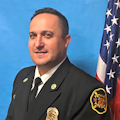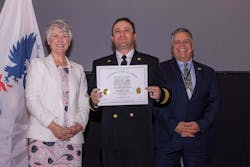5 Steps to Follow to Become a Chief Officer in the Fire Service
Becoming a chief officer in the fire service isn’t just about climbing the ranks or earning certifications. It’s about leading with integrity and gaining the trust of those who stand beside you.
As someone who has walked this path, I realized that success lies in focusing on the people who you lead, not just the chiefs who are above you. Leadership is about influence, respect and staying true to yourself. The leadership journey requires commitment, self-awareness and a genuine connection with the team that you aspire to lead. Without the respect of your peers, any title is meaningless.
Leadership starts with respect. The firefighters who stand beside you today are the ones who you will rely on to follow your lead tomorrow. Throughout my career, I’ve understood that leadership is far less about titles and more about relationships. Trust and loyalty form the foundation of any effective leader’s success. To earn this, you must be dependable, genuine and present. Leadership isn’t built in an office or during formal meetings. It’s earned in the trenches, where real challenges forge strong bonds.
Rather than impressing the chiefs who are above you, concentrate on being there for those who are around you. Share in the hard work—the long nights, the problematic calls—and show genuine care for your team. Those people need to see that you aren’t just a supervisor but a teammate who understands their challenges and values their contributions.
Authenticity is critical. Early in my career, I believed that I had to act in a certain way to fit the mold of a leader, but I learned that being yourself is what truly builds trust. Don’t try to be someone who you believe that others want you to be. Let your actions and decisions reflect your core values. When you work hard and lead by example, respect naturally follows.
The role of education and training
Formal education is imperative for achieving high-level leadership in the fire service. Beyond the knowledge that’s gained through coursework, formal education teaches invaluable skills, such as time management, balancing multiple responsibilities and adapting to diverse situations.
One of the most profound benefits of formal education is the opportunity to meet and collaborate with people who are from all walks of life, which broadens one’s perspective and enriches the ability to lead in varied contexts. These experiences shape leaders who are adaptable, empathetic and prepared to address the complex challenges of modern fire service leadership.
The National Fire Academy (NFA) offers many development opportunities beyond the Executive Fire Officer Program. Its Officer Development Program provides a structured pathway for leaders at every stage of their career. From company officer training to advanced command and control classes, the curriculum is designed to prepare officers for the increasingly complex challenges of modern fire service leadership.
These programs emphasize critical thinking, incident management and team building, to ensure that leaders are well-rounded and ready to meet organizational needs. Participating in these programs profoundly improved my ability to make sound decisions under pressure and effectively manage resources.
Certifications also play an essential role. Earning designations, such as Chief Fire Officer through the Center for Public Safety Excellence, demonstrates a commitment to excellence and prepares a member for the complexities of leadership.
Leadership development courses, such as incident-management training, sharpen decision-making and problem-solving skills, which are essential when responding to high-stress situations.
However, technical knowledge alone isn’t enough. Leadership is about communication, conflict resolution and strategic planning. Investing time in building these soft skills sets great leaders apart.
Staying updated on evolving technology and fire service practices also is vital. Adaptability and knowledge show team members that their leader is prepared to meet future challenges head on.
Broadening perspective through experience
One of the most important lessons that I have learned is the value of stepping outside of my comfort zone.
Attending classes at the NFA or other institutions that are outside one’s region exposes an individual to new perspectives and ideas. When officers stay within the confines of their local department or area, it’s easy for them to become siloed in their thinking, adhering strictly to the practices and traditions that they know. However, exposure to peers from diverse backgrounds and organizations can challenge one’s assumptions and expand one’s thought process. These experiences might confirm that some of current practices are effective while highlighting areas that could benefit from change or innovation. For me, these opportunities brought clarity, not just about operational decisions but also about my leadership style. Yes, realizing that growth often comes from listening, learning and embracing different viewpoints is humbling, but it also is rewarding.
As officers advance in leadership, their perspective must broaden to match the responsibilities of their role. Leadership at higher levels demands a departure from a narrow view. Instead, a chief officer must adopt a strategic, overarching perspective that considers the organization’s needs, the community and the broader fire service. A limited focus on immediate issues or specific divisions doesn’t translate to effective leadership at the executive level. By thinking holistically, leaders ensure that their decisions are informed by a comprehensive understanding of how each element of the organization connects and contributes to its overall success. This higher-level perspective allows leaders to anticipate challenges, build innovation and make decisions that benefit the department.
The importance of humility in leadership
Humility is a cornerstone of effective leadership. Leaders who admit mistakes and demonstrate a commitment to growth earn their team’s respect and promote a culture of accountability and continuous improvement. Being open about errors doesn’t diminish authority; it humanizes the leader and strengthens trust within the organization.
As a leader, I learned that no one has all of the answers and that perfection is unattainable. When I make a mistake, I own up to it and take proactive steps to learn from the experience. This approach encourages others to do the same, which creates an environment where team members feel safe to innovate, take calculated risks and grow from their own missteps.
Seeking honest feedback is another critical aspect of humility. Surrounding yourself with people who are upfront and candid about your performance provides invaluable insights. I actively seek input from peers, mentors and even those who I lead to gain different perspectives on my leadership style and decisions. Honest feedback helps me to identify blind spots and to make informed adjustments, ultimately leading to better outcomes for the team and organization.
Humility also requires prioritizing the team’s needs over personal ambitions. A humble leader celebrates others’ successes, acknowledges contributions and ensures that credit is shared. This mindset promotes collaboration and loyalty, which are essential for achieving organizational goals.
By embracing humility, admitting mistakes and committing to continuous self-improvement, leaders can inspire their team to reach new heights. Leadership isn’t about projecting an image of infallibility; it’s about showing that growth and learning are lifelong pursuits and that leading by example is one of the most powerful tools that a leader possesses.
Community engagement and professional networks
A chief officer’s influence extends beyond the station walls. Community involvement is a cornerstone of effective leadership. Participating in local events and educational programs builds trust and strengthens connections. School visits, fire prevention initiatives and partnerships with local businesses create community engagement opportunities.
Advocating for one’s department and its needs is another crucial aspect. I’ve had to advocate for resources and programs that directly affect public safety. Using data and real-life stories can help to make a compelling case for elected officials and stakeholders. Visibility and approachability are essential. Community members notice when their leaders show up, listen and act. Being present builds trust and reinforces your commitment to service.
Another essential growth element is connecting to the broader fire service community through professional memberships and affiliations.
Joining organizations, such as the International Association of Fire Chiefs and the National Fire Protection Association provides access to resources, training and networking opportunities. Serving in leadership roles within these organizations demonstrates a commitment to professional excellence and allows contribution to the fire service on a larger scale.
Conferences and similar events are excellent venues for meeting peers and mentors, sharing ideas, and being informed about industry trends.
Leave a legacy
Becoming a chief officer is more than achieving a rank. It’s about embracing the responsibility to lead with integrity and authenticity and a commitment to bettering the fire service and community. Leadership requires continuous learning, humility and a willingness to adapt. By building trust, investing in personal growth and broadening perspective, officers can develop the skills and relationships that are necessary to have a meaningful effect.
Remember, every experience along the way contributes to the journey. Whether successes or setbacks, these moments shape the leader who you are becoming. Stay focused on long-term vision and always appreciate the value of persistence and determination. Leadership isn’t about titles or accolades but about the positive difference that can be made in the lives of team members and the community. Lead with purpose, leaving a legacy of excellence and service that future generations will admire.
About the Author

Chad Costa
Chad Costa is the assistant chief for the Petaluma, CA, Fire Department. With more than 26 years of fire service experience, he has worked in various organizations, including CAL FIRE, rural and semi-rural districts, and a city. As a battalion chief, Costa was the technology and communications battalion chief. He is now a rostered operations branch director for CalFire Team 1 and an alternate operations section chief trainee on California Interagency Team 5. Costa is an accredited Chief Fire Officer through the Center for Public Safety Excellence and has a bachelor’s degree in emergency services management, a master’s degree in fire service leadership, and a certificate in homeland security. Costa has also completed the Executive Chief Officer Program at the National Fire Academy. Costa is a member of the Firehouse Editorial Advisory Board.
